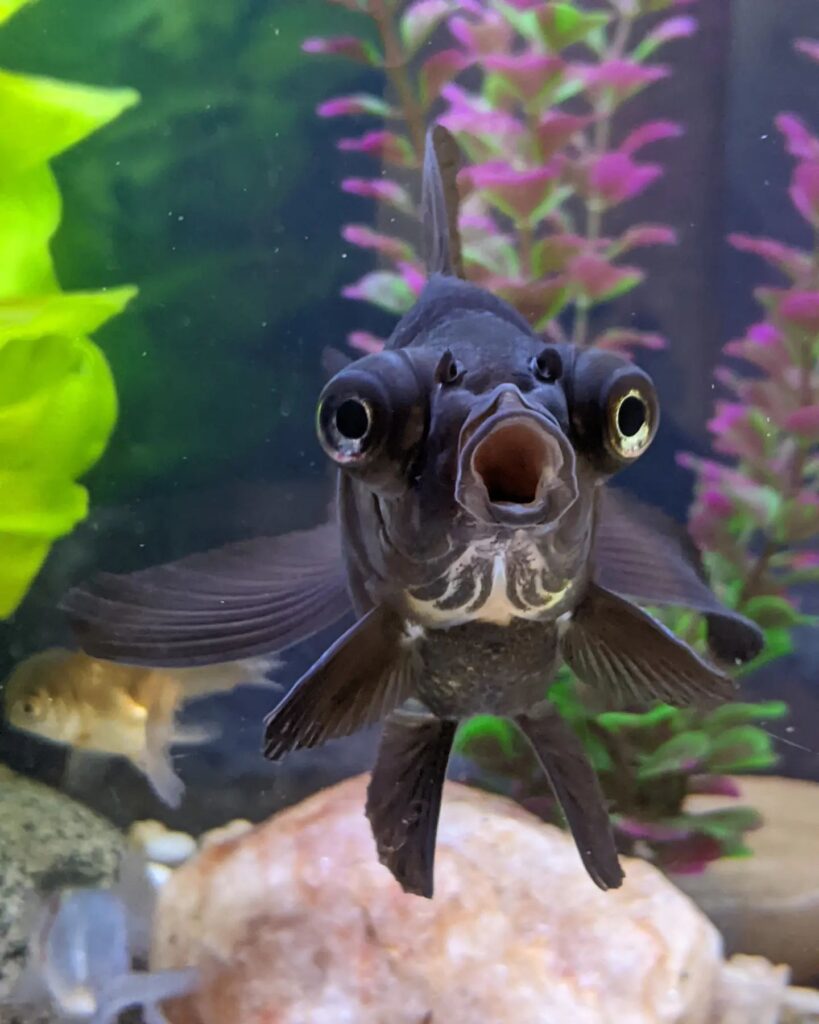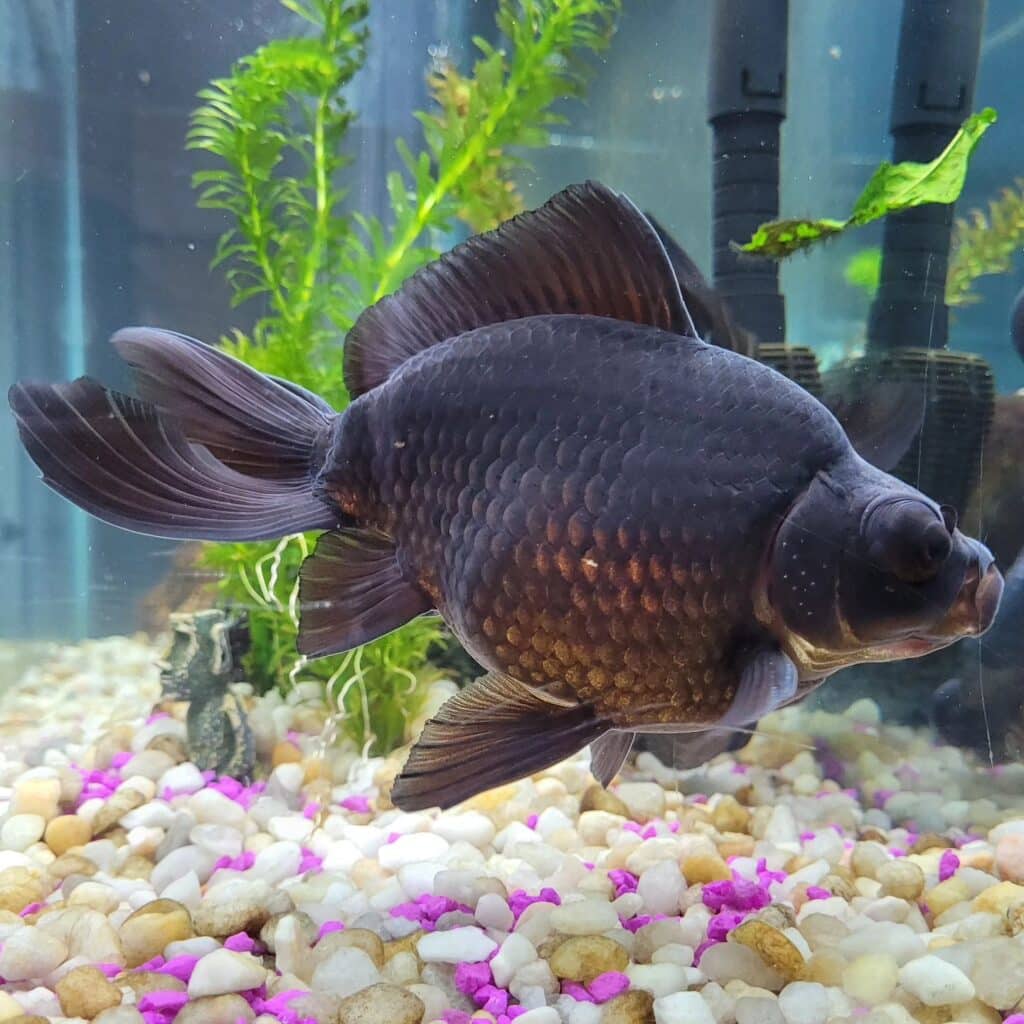Black Moor Goldfish: Passion of Experienced and Novice Hobbyists
For their stunning black color and graceful swimming manner, Black Moors are exceptionally inspiring goldfish. Aquarists admire the dragon eyes that set Black Moors apart from other exotic varieties of goldfish. Black Moor goldfish is one of the most distinctive aquarium fish, drawing in both experienced and novice hobbyists.
If you’re considering adding this black beauty to your aquarium, keep in mind that maintenance for Black Moors differs slightly from caring for other Goldfish, making them more approachable for freshmen and increasing their appeal.
This comprehensive guide to black moor goldfish includes all the necessary details, so read on to discover everything there is to know about these remarkable creatures.
Origins of Black Moor Goldfish
Along with its widely recognized names, the Black Moor goldfish is sometimes referred to as the Dragon Eye goldfish and the Black Peony goldfish.
Since this kind of Fancy goldfish is an artificial invention, you will never find it living in the wild. Black Moor goldfish are similarly related to a species of wild Silver Prussian Carp that is found in Central Asia. They are found in lakes, rivers, and ponds with slow-moving currents and consume insect larvae, microorganisms, plant materials, and other debris.
Chinese Buddhist monks kept the ancestors of Black Moor goldfish in ponds and raised them as food fish in the 1500s. However, due to a genetic abnormality, a few vibrantly colored fish emerged, which the monks preserved as decorative samples. Years of selective breeding led to the creation of earlier iterations of Black Moor goldfish as well as additional colorful fish varieties.
In the late 1800s, goldfish gained considerable prominence as ornamental pond fish in the US and were traded with Europe by the 1600s. There are currently about 125 distinct kinds of fancy fantail goldfish, the majority of which are egg-shaped variants.
Appearance & Behavior
With their huge, outward-facing eyes, rich black, silky metallic scales, spherical bodies, and long, flowing fins, Black Moor goldfish are clearly distinguished from other goldfish species. Black moor goldfish have bronze or gold bodies as juveniles, but as they get older, they develop black bodies and protruding eyes. These fish have poor vision despite having exceptionally huge eyes.
It is challenging to identify black moor goldfish gender because, except for size, there is no visual difference between males and females. Males distinguish themselves from females by developing little white bumps on their pectoral fins during the spawning season known as breeding tubercles.
The black moor goldfish is a calm, slowly moving fish that socializes well with other fish and is not possessive. When scared by loud noises or aggressive tank companions, this goldfish prefers to hide and swim in the middle of the tank. Black moor goldfish are most active during the daytime when eating and exploring their tank. At night, they sleep in caves or under plants.
Black Moor Goldfish Feeding Habits
Black Moor goldfish require a high-quality diet since they are extremely sensitive to overfeeding and swim bladder disorders. They need a diet rich in high-quality protein and vegetables, as well as sinking pellets, flakes, or gels that are low in needless substitutes and high in protein and fiber.
Black moors are carnivores, so they respond favorably to several easily digestible fresh meals or freeze-dried foods, like brine shrimp, bloodworms, and blackworms. However, you should first soak freeze-dried food in aquarium water before giving it to your black moors to encourage a more efficient digestion process.
How to Take Care of Black Moor Goldfish? 5 Main Considerations
1. Water Parameters

The ideal water temperature for black moors is between 65 and 72 degrees Fahrenheit. With a pH of between 6.0 and 8.0, the water should have a hardness of 5 to 19 dGH. Every week, you have to employ a digital aquarium thermometer to check the water’s parameters and make sure that the nitrate level is 20 ppm or below and that there are no ammonia or nitrite remnants in the water.
It is advised to use an aquarium vacuum to effectively remove organic debris and leftovers around plant bases, decorations, and underneath internal filter boxes. If you retain plants in your aquarium, you should also use aquascaping scissors to remove any fallen leaves or stems that are damaged or dead.
2. Filtration
Black Moor Goldfish are messy creatures that generate excessive amounts of waste daily. Thus, a powerful filtration system will be required to maintain the water’s sanitation and quality. To remove solid waste and pollutants from the water that circulates through the aquarium at least four times per hour, the filtration system requires both biological and mechanical filter media. However, keep in mind to eliminate the chemical filter first if you plan to inject the water with fish medication.
Black Moors are awkward swimmers who will have trouble surviving in a strong stream. Therefore, bear that in mind when selecting your filter. Use plants or decorations to slow the flow instead, or choose a system with an adjustable outflow regulation option.
3. Safety Considerations

Due to their large, projecting eyes and lack of vision, Black Moors are particularly vulnerable to harm in densely packed tanks. Therefore, provide plenty of open water swimming space in the middle of the water pillar and place any substantial decorations on the surface or around the tank’s edges.
It is advisable to experiment with smooth driftwood, pebbles, or rocks if you intend to create a natural effect in your arrangement. We advise you to stay away from twisted roots and other objects with sharp edges. The best material for the tank bottom is large-gauge, smooth gravel since fish enjoy spending time exploring the substrate in search of food crumbs.
4. Planting
Living plants are a great option for your fish tank since they improve the atmosphere for your fish by producing oxygen and absorbing CO2 and nitrates. Black Moor goldfish delight in nibbling on the leaves of infantile plants. Marimo moss balls, Java fern, and anubias are a few charming plant species that you can keep in a goldfish tank without much risk of harm due to the fish’s constant rummaging in the substrate.
5. Lighting

Even though fish do not necessarily require light in their surroundings, Black Moors who have impaired vision can benefit from illumination since it can help them navigate. Additionally, lighting resembles the day and night cycles, which are essential for the health of your goldfish. This particular cycle lowers goldfish stress levels since the fish can determine when it’s time to eat and sleep by the rising and setting of the sun.
To avoid worrying about turning on and off the lights in your aquarium when you’re not around, getting a lighting unit with an integrated auto-timer is a sensible idea. You can get a straightforward timer plug at your local retailer as a less expensive, equally efficient substitute.
Black Moor Goldfish Breeding
In comparison to other goldfish, which usually start breeding between 1.5 and 2 years after reaching maturity, black moors can reproduce as early as the age of 1 year. For an increased chance of acquiring a mix of males and females, you should have at least 5 goldfish in the tank. Outside of the breeding season, it’s virtually impossible to tell the difference between the two genders.
However, throughout the breeding season, females are typically rounder when they are carrying eggs. Breeding stars, which are tiny dots that are frequently observed on male goldfish’s gill area, are also easy to identify because of the contrast between the white dotting and the black coloration.
Increased food availability, warmer water temperatures, and longer daylight hours might trigger Black Moor Goldfish to start reproducing. Before putting the Black Moor goldfish in the spawning tank, offer them a meal high in protein to get them ready for breeding. After the fish start to spawn, you have to keep feeding them a high-quality, high-protein diet that includes plenty of brine shrimp, bloodworms, and other comparable nutrients.
The female may become stressed out as a result of the typical mating activity of chasing and pushing, so be sure to keep an eye on her if you notice this behavior. It is advisable to gently separate the eggs and the fry as they hatch because goldfish typically devour their eggs or young.
How Much Do Black Moor Goldfish Cost?
Prices for Black Moor goldfish can vary depending on where you get them. A Black Moor that was raised at a pet shop will probably be less expensive, although it is more likely to have medical conditions. Breeders generally breed and stock premium goldfish, so expect to pay more, with costs ranging from $5 to $20, depending on size, beauty, and health. Standard pet store pricing can range from $2 to approximately $15, and you will probably pay less at a high-end chain pet store.
Final Thoughts
After perusing the whole article and learning the fundamentals of Black Moor, you might be eager to get this unique variety of goldfish for your aquarium. Now that you are aware of the significance of having sufficient space, time, filtration, and maintenance, you can ensure that your existing goldfish tank is safe for keeping this exceptional species.
So, in case you had any doubts, you can now rest assured that Black Moor will be a great addition to your aquarium.

Nato is a content writer and researcher with a background in psychology who’s eager to explore the wonders of nature. As a travel enthusiast and animal lover, she hopes to inspire others to discover and cherish the beauty and importance of the natural world.







